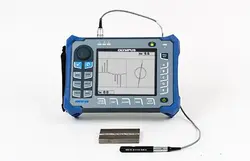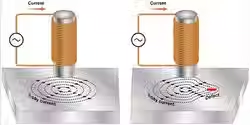
Eddy Current Testing. (ET).
Alternate names may include:
ET: Eddy Current Testing. ECT: Eddy Current Testing.
Eddy Current Testing. (ET).
Eddy current testing is based on the physical phenomenon of electromagnetic induction.
In an eddy current probe, an alternating current flows through a wire coil and generates an oscillating magnetic field.
If the probe and its magnetic field are brought close to a conductive material, such as a metal test piece, a circular flow of electrons known as an eddy current begin to move through the metal like swirling water in a stream. That eddy current flowing through the metal in turn generates its own magnetic field, which interacts with the coil and its field through mutual inductance. Changes in metal thickness or defects, such as near-surface cracking, interrupt or alter the amplitude and pattern of the eddy current and the resulting magnetic field.
This in turn affects the movement of electrons in the coil by varying the electrical impedance of the coil. The eddy current instrument plots changes in the impedance amplitude and phase angle, which can be used by a trained operator to identify changes in the test piece.
Eddy currents traveling in materials with higher conductivity values are more sensitive to surface defects but have less penetration into the material, with penetration also being dependent on test frequency. Higher test frequencies increase the near-surface resolution but limit the depth of penetration, while lower test frequencies increase penetration.
In a given test, resolution is determined by the probe type while detection capability is controlled by material and equipment characteristics.
Eddy current testing is widely used in the aerospace, shipping, oil and gas, transport and general engineering industry
In addition to crack detection in metal sheets and tubing, eddy current testing can be used for certain metal thickness measurements such as identifying corrosion under aircraft skin, measuring conductivity and monitoring the effects of heat treatment, and determining the thickness of nonconductive coatings over conductive substrates.
Eddy current NDT can examine large areas very quickly, and it does not require the use of coupling liquids.
In addition to finding cracks, eddy current testing can also be used to check metal hardness and conductivity in applications where those properties are of interest, and to measure thin layers of nonconductive coatings, such as paint on metal parts.
At the same time, eddy current testing is limited to materials that conduct electricity and thus cannot be used on plastics.
Common eddy current testing applications are listed below:
-
Weld inspection—Many weld inspections use ultrasonic NDT for subsurface testing and a complementary eddy current method to scan the surface for open surface cracks on weld caps and in heat-affected zones (HAZ).
-
Conductivity testing—Eddy current testing’s ability to measure conductivity can be used to identify and sort ferrous and nonferrous alloys and to verify heat treatment.
-
Surface inspection—Surface cracks in machined parts and metal stock can be readily identified with eddy current. This includes inspection of the area around fasteners in aircraft and other critical applications.
-
Corrosion detection—Eddy current instruments can be used to detect and quantify corrosion on the inside of thin metal such as aluminium aircraft skin. Low-frequency probes can be used to locate corrosion on second and third layers of metal that cannot be inspected ultrasonically.
-
Bolt hole inspection—Cracking inside bolt holes can be detected using bolt hole probes, often with automated rotary scanners.
-
Tubing inspection—Both in-line inspection of tubing at the manufacturing stage and field inspection of tubing such as heat exchangers are common eddy current applications. Both cracking and thickness variations can be detected.
 |  |  |  |
|---|---|---|---|
 |  |  |  |
 |